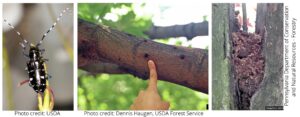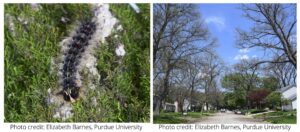It can sometimes feel like the struggle with invasive species is never ending but equipping yourself with the right knowledge can go a long way to lessening their impact. Each species has its own quirks, but there are common themes that explain why these species are a problem, how to slow their spread, and how to manage them. This Invasive Species Awareness Week take a few minutes to read on and refresh your invasive insect knowledge!
What are invasive species?
When talking about invasive species, we tend to group organisms broadly into three categories: native, non-native, and invasive.
Natives species are ones that live in a given area because of non-human means. Generally, these insects, plants, and other organisms are tightly woven into the ecosystem. They may provide benefits to other organisms (e.g. native plants are a food source for beneficial insects) and, outside of outbreaks, their population size is kept from going out of control through the checks and balances of the ecosystem (e.g. predators that only eat certain types of insects).
Non-native species are those that were transported long distances by humans to a new area. They are separated from the ecosystem that they developed in and its checks and balances. Non-native species can have a positive, neutral, or negative impact on their surroundings, though they most commonly have either a neutral or negative impact.
Invasive species are a type of non-native species that were moved long distances by humans, escaped out of captivity or cultivation, established a reproducing population in the wild, and, importantly, cause harm to people and/or the environment. Therefore, the key trait that differentiates invasive species from other non-native ones is that they cause harm. For example, apple trees are not native to North America but even when they grow outside of cultivation they do not cause any significant harm to humans or the broader ecosystem. Apples are therefore simply referred to as a non-native species. In contrast, callery pear spreads aggressively in woodlands and pushes out other plants thereby causing harm to both people and the environment. Thus, callery pear is a non-native species that is invasive.
Why are invasive species a serious problem?
Invasive insects cause a wide range of problems for people and the environment: some expected and some surprising. For example, the loss of a yard tree to an invasive insect can cause a decrease in home value and a loss of food for beneficial insects. However, it can also lead to an increase in flooding because the roots no longer take up water during heavy rainfall and a decrease in bird population because of a reduction in the insects birds feed their chicks.
How are invasive insects spread?
Invasive insects primarily spread through people moving their food, shelter, or eggs. Organic matter, like leaves, soil, or wood can all provide invasive insects with food or shelter. Insects can stay hidden inside these materials and remain completely undetected by the person transporting them. Some invasive insects are also undiscerning about where they lay their eggs. Lawn chairs, trucks, and outdoor lightbulbs are all places where invasive insect eggs have been found. You can help prevent bringing these invasive insects to new areas by:
- Buying or cutting firewood near where you plan to burn it.
- Cleaning dirt off of shoes and equipment before going to a new area.
- Checking plants for insects when you receive them.
- Checking your outdoor equipment and vehicles before traveling to a new site.
- Checking your outdoor belongings before and after moving to a new area.
- Reporting them if you find them!
Insects to Watch Out For
Spotted Lanternfly
Damage: Spotted lanternfly kills grapes and some small trees, weakens trees and shrubs, and creates a mess for businesses and homeowners alike. These insects drink the sap from over 100 different species of plants, but especially species like grapes, tree of heaven, black walnut, maples, and birches.
Signs: Spotted lanternfly damage is undistinctive but the insect itself stands out (image 1). In early summer, the nymphs are small with black and white spots. In mid to late summer they are nearly fuchsia with black and white spots. In late summer and fall, the adults are large (~1 inch) with black spotted forewings and flashy fuchsia, white, and black hind wings.
Management: In most cases, hold off on management until the lanternfly reaches your area. For plants, like grapes, that are highly susceptible to spotted lanternfly, best management practices often involve a combination of insecticides and trapping. Other plants can be protected using similar measures but these tactics may be unnecessary outside of outbreaks or special cases. However, spotted lanternfly management is a fast-changing field. The author highly recommends checking the Penn State Extension Spotted Lanternfly site for the latest suggestions.

Asian longhorned beetle and its signs. The first image shows an adult beetle. The second is of several perfectly round exit holes made by the beetle. The third image shows a typical amount of “sawdust” that accumulates in the crooks of trees infested by Asian longhorned beetle.
Asian Longhorned Beetle
Damage: Asian longhorned beetle infestation is a death sentence for a tree. This insect kills a wide range of trees (e.g. maples, buckeyes, elms) by hollowing them out.
Signs: The adult beetle is very eye catching (image 2). It is about 1 inch long and has a blue-black body with white spots. Their antennae are longer than their bodies and are black and white striped. The beetles also leave behind distinctive signs of their presence in their host trees. Look for trees with perfectly round holes about the size of a pencil, “crater” shaped scars in bark, and piles of “saw dust” in the crooks of branches (image 2).
Treatments: Report any signs or sightings of this beetle! An eradication plan will be put into place if the beetle is found to prevent it from spreading further. These efforts have been highly successful in the past and have kept the beetle from destroying our urban and rural forests.

Emerald ash borer is more easily recognized by its damage than by the beetle itself. The first image shows the typical s-shaped patterns that appear under the bark of trees damaged by emerald ash borer. The second image shows how ash trees killed by emerald ash borer can break and shatter in unexpected ways. The third image is of the d-shaped exit holes emerald ash bores make in tree bark.
Emerald Ash Borer
Damage: Emerald ash borer only attacks ash trees. About 95-99% of trees that have been infested with this insect die with in 2-4 years.
Signs: Early warning signs of emerald ash borer infestation include dieback of the tree canopy and d-shaped exit holes in the tree bark (image 3). In later stages of attack, there is often a high amount of woodpecker activity around the trees and the bark may flake off revealing s-shaped patterns in the cambium (image 3).
Treatments: Insecticide treatments for emerald ash borer are highly effective and often cheaper than tree removal. If a tree has been killed by emerald ash borer, it is critical to have it removed by a certified arborist. These trees are highly unpredictable and have caused serious injury and death even in calm weather conditions.
Spongy Moth (Formerly Gypsy Moth)
Damage: The soon to be renamed spongy moth feeds on the leaves of trees, especially oak trees. In outbreak years, they can defoliate the trees in an entire neighborhood (image 4). Healthy, deciduous trees (those that drop their leaves in the fall) can usually recover from one year of defoliation. Stressed, evergreen, and/or previously defoliated trees may suffer dieback or death from spongy moth attack.
Signs: The egg and caterpillar stages are the most recognizable (image 4). Egg masses look like brown lumps covered in fuzz. They can be found on anything from a house to a car to a shovel. Caterpillars are fuzzy with two rows of blue and red dots on their backs.
Treatments: Management options range from egg scraping to arial sprays but all are most effective when done by an entire neighborhood. You can find tips on choosing the right options here.
Want to learn more?
Purdue will be sharing invasive species information all week on twitter (@reportINvasive and @PurdueFNR) and Facebook (reportINvasive and Purdue Forestry and Natural Resources).
EABU will host two free webinars this week on invasive species this week. CEU credit will be available.
To learn more about invasive plants, check out the article on native alternatives in this Purdue Landscape Report Issue!
Seen an invasive species? Report it!
- The GLEDN Phone App
- EDDMapS
- 1-866 NO EXOTIC (1-866-663-9684)
- depp@dnr.IN.gov

